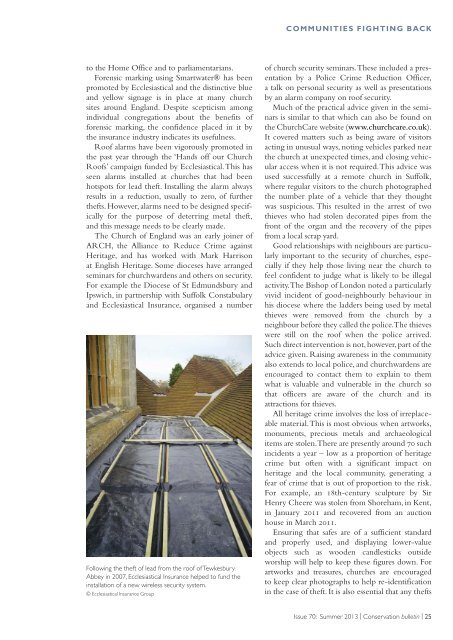Conservation Bulletin 70 | PDF - English Heritage
Conservation Bulletin 70 | PDF - English Heritage
Conservation Bulletin 70 | PDF - English Heritage
Create successful ePaper yourself
Turn your PDF publications into a flip-book with our unique Google optimized e-Paper software.
COMMUNITIES FIGHTING BACK<br />
to the Home Office and to parliamentarians.<br />
Forensic marking using Smartwater® has been<br />
promoted by Ecclesiastical and the distinctive blue<br />
and yellow signage is in place at many church<br />
sites around England. Despite scepticism among<br />
individual congregations about the benefits of<br />
forensic marking, the confidence placed in it by<br />
the insurance industry indicates its usefulness.<br />
Roof alarms have been vigorously promoted in<br />
the past year through the ‘Hands off our Church<br />
Roofs’ campaign funded by Ecclesiastical.This has<br />
seen alarms installed at churches that had been<br />
hotspots for lead theft. Installing the alarm always<br />
results in a reduction, usually to zero, of further<br />
thefts. However, alarms need to be designed specifically<br />
for the purpose of deterring metal theft,<br />
and this message needs to be clearly made.<br />
The Church of England was an early joiner of<br />
ARCH, the Alliance to Reduce Crime against<br />
<strong>Heritage</strong>, and has worked with Mark Harrison<br />
at <strong>English</strong> <strong>Heritage</strong>. Some dioceses have arranged<br />
seminars for churchwardens and others on security.<br />
For example the Diocese of St Edmundsbury and<br />
Ipswich, in partnership with Suffolk Constabulary<br />
and Ecclesiastical Insurance, organised a number<br />
Following the theft of lead from the roof of Tewkesbury<br />
Abbey in 2007, Ecclesiastical Insurance helped to fund the<br />
installation of a new wireless security system.<br />
© Ecclesiastical Insurance Group<br />
of church security seminars.These included a presentation<br />
by a Police Crime Reduction Officer,<br />
a talk on personal security as well as presentations<br />
by an alarm company on roof security.<br />
Much of the practical advice given in the seminars<br />
is similar to that which can also be found on<br />
the ChurchCare website (www.churchcare.co.uk).<br />
It covered matters such as being aware of visitors<br />
acting in unusual ways, noting vehicles parked near<br />
the church at unexpected times, and closing vehicular<br />
access when it is not required.This advice was<br />
used successfully at a remote church in Suffolk,<br />
where regular visitors to the church photographed<br />
the number plate of a vehicle that they thought<br />
was suspicious. This resulted in the arrest of two<br />
thieves who had stolen decorated pipes from the<br />
front of the organ and the recovery of the pipes<br />
from a local scrap yard.<br />
Good relationships with neighbours are particularly<br />
important to the security of churches, especially<br />
if they help those living near the church to<br />
feel confident to judge what is likely to be illegal<br />
activity.The Bishop of London noted a particularly<br />
vivid incident of good-neighbourly behaviour in<br />
his diocese where the ladders being used by metal<br />
thieves were removed from the church by a<br />
neighbour before they called the police.The thieves<br />
were still on the roof when the police arrived.<br />
Such direct intervention is not, however, part of the<br />
advice given. Raising awareness in the community<br />
also extends to local police, and churchwardens are<br />
encouraged to contact them to explain to them<br />
what is valuable and vulnerable in the church so<br />
that officers are aware of the church and its<br />
attractions for thieves.<br />
All heritage crime involves the loss of irreplaceable<br />
material.This is most obvious when artworks,<br />
monuments, precious metals and archaeological<br />
items are stolen.There are presently around <strong>70</strong> such<br />
incidents a year – low as a proportion of heritage<br />
crime but often with a significant impact on<br />
heritage and the local community, generating a<br />
fear of crime that is out of proportion to the risk.<br />
For example, an 18th-century sculpture by Sir<br />
Henry Cheere was stolen from Shoreham, in Kent,<br />
in January 2011 and recovered from an auction<br />
house in March 2011.<br />
Ensuring that safes are of a sufficient standard<br />
and properly used, and displaying lower-value<br />
objects such as wooden candlesticks outside<br />
worship will help to keep these figures down. For<br />
artworks and treasures, churches are encouraged<br />
to keep clear photographs to help re-identification<br />
in the case of theft. It is also essential that any thefts<br />
Issue <strong>70</strong>: Summer 2013 | <strong>Conservation</strong> bulletin | 25

















